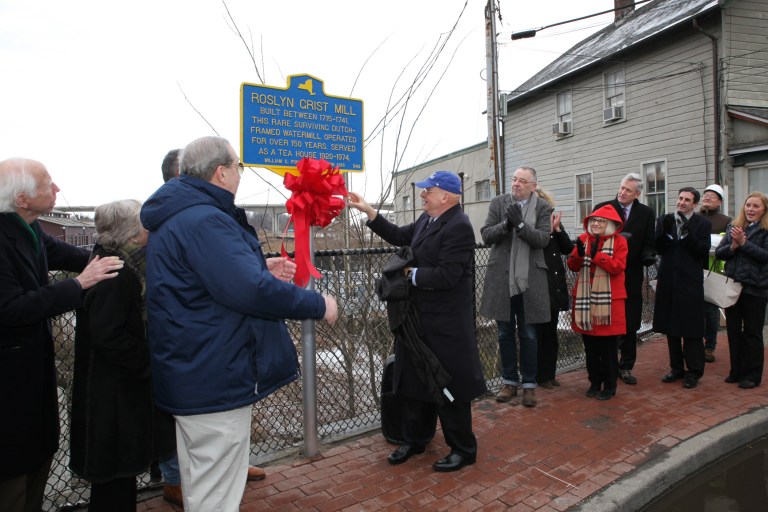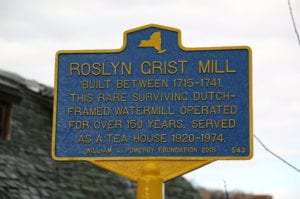
The Roslyn Landmark Society welcomed a new addition to the Roslyn Grist Mill site Wednesday: a blue marker with yellow lettering that explains the mill’s history.
In a single sentence, the marker tells how the grist mill operated for more than 150 years and was later a tea house.
It comes as the Roslyn Landmark Society continues to restore the site.
“Really it’s the first time that when people drive by there they get an understanding of what this building is,” said Roslyn Landmark Society president Howard Kroplick. “It’s so strange – I’ve talked to people who’ve lived here for years and they go, ‘Where is the Roslyn Grist Mill?’ and I say, ‘It’s right in the middle of the village’…so now no one will have the excuse of not knowing what the grist mill is.”
Government officials, ranging from those representing the state to local villages, celebrated the marker’s arrival on Wednesday.

“The Roslyn Grist Mill is such an important part of the rich history that belongs to the Town of North Hempstead and to the Village of Roslyn,” said North Hempstead Town Supervisor Judi Bosworth. “The unveiling of this new historical maker will also help future generations learn about the significant role the Roslyn Grist Mill played in the development of our local community.”
The William G. Pomeroy Foundation funded the marker. It has done so for nearly 800 markers and plaques “in New York State and beyond” according to its website.
The Roslyn Grist Mill was built in the 1700s and is one of the last timber-frame structures in the country built by Dutch settlers.
The Roslyn Landmark Society has raised nearly $2 million for the restoration project, which will continue for a couple of years, Kroplick said. The historical society plans to use the completed site to educate the public and host exhibits.
Work on the first phase of the site’s restoration, is ongoing, Kroplick said, and in the spring, the building will be raised to street level.
“It’s going to be very dramatic when we lift the building,” Kroplick said. “It’s going to go to street level for the first time since I think about 1890.”
Having a historic marker at the grist mill reinforces the work that’s going on to restore it, he said.
“I’ve been a resident for over 35 years, and I’ve been hearing about this grist mill almost since the day I moved into the area so it’s nice to see we’ve finally got it going,” he said.







I have an ancestor, named John Robeson (Robison, Robinson) who in Hempstead town records was given rights to build a mill in this spot both in 1698 and reconfirmed in 1701. It’s said the mill was built at the head of the harbor shortly after 1701. Could this mill have been built earlier than supposed? Do you know why the name Robeson is associated with this mill?